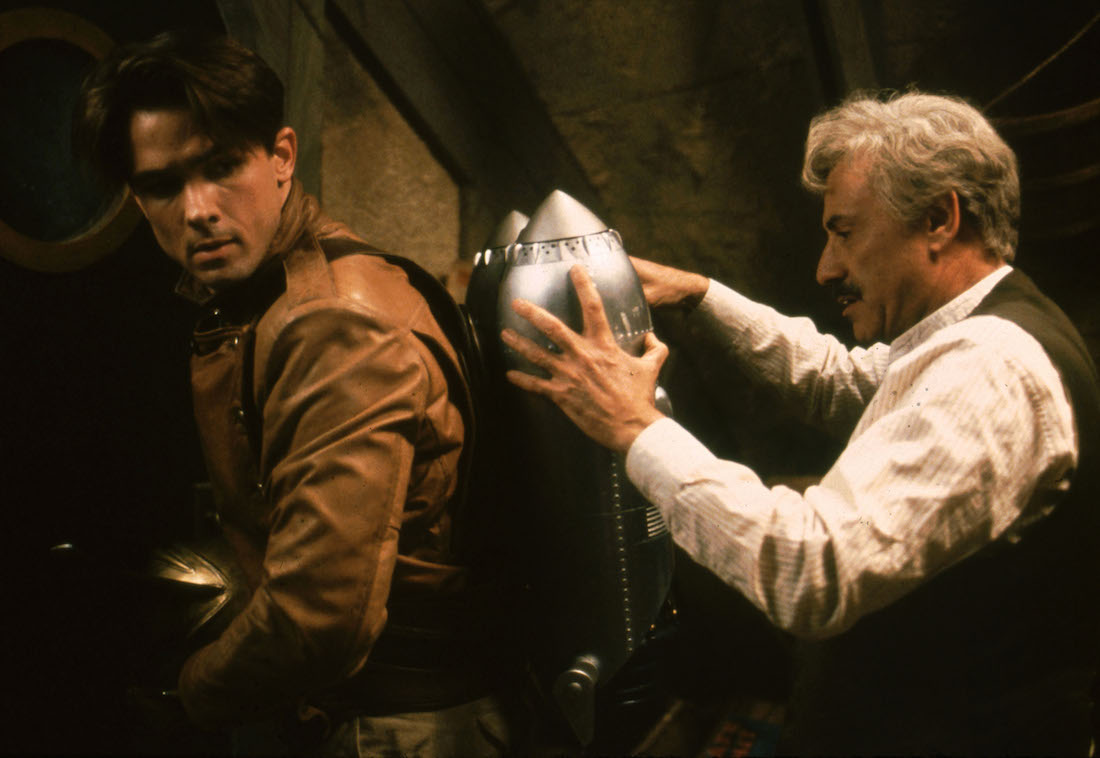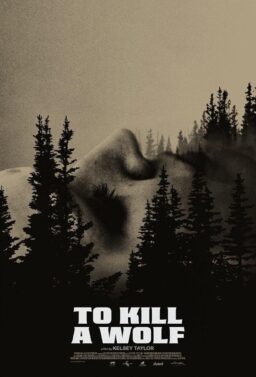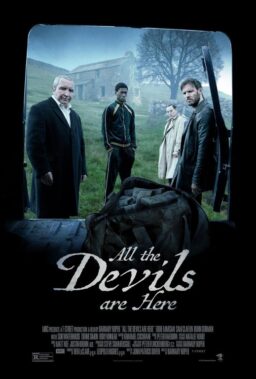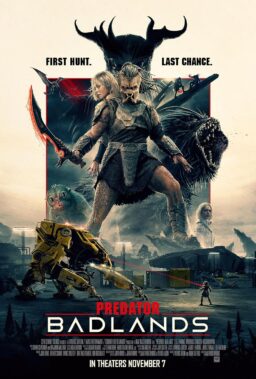“All my vague cartoon ambitions suddenly fused into one crystal clear goal: to draw dramatic, emotionally-charged, energized scenes of power, grandeur, and intensity. It was like movie-making on paper, and you were the writer, designer, and director.”—Dave Stevens, creator of The Rocketeer
“I’ve bought a ticket in a lottery, the grand prize of which amounts to this: being read in 1935.”—Stendhal
We open on a black screen, as the Copland-esque Americana of James Horner’s score (rightly described by Jessica Ritchey as “the best John Williams never did”) plays under the deco-style lettering of the movie’s credits. After “The Rocketeer” appears (with lightning bolt edges on its “R” and “E”s), the screen and the title suddenly splits in two, as if what we’re seeing is a curtain, and there’s another screen behind it, waiting to burst into view. Silhouettes push “Rock” and “Eteer” and the black backdrop to either side of the frame, as dewy light reveals a prop plane on the yellow gravel of a runway, green trees and a slightly overcast blue sky a bit blurry on the horizon. We’re seeing all this from the perspective inside the hanger, and even as the cut to the next shot reveals another plane (the yellow, snub-nosed “Gee Bee Model R”) being rolled out, the framing remains masked at its 2.35:1 edges, as if pitched between an older, Depression-era framing of literal “squareness” and the broader spectacles of late 20th century Hollywood.
Before we know who these silhouettes on the screen are, before a word is spoken—indeed, before we know anything about the story at all—“The Rocketeer” has given us all of its pertinent information. This is going to be a film full of both reverence for a period past and a playful deconstruction of that era’s movie tropes; it will use theatrical slight of hand to create a hyper-real vision of the 1930s; and not despite but because of this “split personality” of style, period, and image, it will fly.
Released 25 years ago this month, “The Rocketeer”—director Joe Johnston and screenwriters Danny Bilson and Paul De Meo’s adaptation of Dave Stevens’ acclaimed indie comic—was pitched as Disney’s second attempt (after the previous year’s equally stylized, period-set “Dick Tracy”) to compete with “Batman,” after that film stormed theaters in 1989. It had rising stars like Bill Campbell (making his film debut after gaining good notices for work on TV shows like “Crime Story” and “Dynasty”) and Jennifer Connelly; a marvelous villain portrayed by the most recent-James Bond, Timothy Dalton; well-regarded character actors like Alan Arkin, Paul Sorvino and William Sanderson in key supporting roles; a screenwriting team who’d just show-run a well-received adaptation of “The Flash” for CBS; and a director coming off the surprise hit of “Honey, I Shrunk The Kids.” The gorgeous, painted Art Deco poster captured the look of Stevens’ comic brilliantly for longtime fans, while grabbing the eyes of those (like 18-year old me), who’d never heard of the Rocketeer in 1991, but were certainly curious to see what this flying helmeted man was all about.
In retrospect, Disney’s hope that they had the next Dark Knight on their hands seems both commercially understandable—a trend is a trend, after all—and utterly bizarre, because its hard to think of a comic book movie that’s less like Tim Burton’s take on Batman than “The Rocketeer” (except maybe Warren Beatty’s “Dick Tracy,” also wonderful). Burton’s playfulness is dark and surreal, full of nods to Expressionist horror, experimental animation and tacky television shows; his hero is conflicted and woefully inarticulate when it comes to expressing his feelings; the gothic villain is the film’s true heart, and the movie has a lot of fun playing with the Hitchcockian “doubleness” of his relationship to our nominal hero. Burton’s movie also has Prince songs.
“The Rocketeer”? Its hero might stumble over his words, but he does so in a Jimmy Stewart-like fashion, so full of gee-whiz energy that he sometime forgets himself before zooming off to the next crazy coincidence. The film is full of daytime shots and bright light, of reflections off the cars and planes, checkerboard dance floors, sequined dresses and metal helmets that make up its mise-en-scène. Most crucially, the movie’s spirit is deeply optimistic—it uses its satire not just to poke fun at old-time serial cliches, but to cast a light back on the present, and remind us of what we might have lost in the 53 intervening years. Horner’s score is key—this is superhero fable as a slice of deeply-felt Americana.
No wonder it flopped in 1991!
Billy Campbell would later blame the marketing, saying that Deco poster which grabbed me didn’t necessarily appeal to kids. Joe Johnston complained of studio interference, and told Premiere magazine he never wanted to work for Disney again. Disney wondered why the movie wasn’t more like “Batman.” The truth was somewhat more prosaic: the film was a victim of summer scheduling. Sandwiched in the week between the releases of “Robin Hood: Prince of Thieves” and “Terminator 2: Judgment Day,” “The Rocketeer” got very strong reviews and eventually found a cult following on home video, but it sunk at the box office, killing Disney’s hopes for a franchise and sending its toys (as Stevens notes in his wry, posthumous memoir, “Brush With Passion”) deep into the discount bins.
And yet, looking at it now, its retro optimism feels like a road-map to the future, a presaging of precisely the blend of action, wit, nostalgia and pathos that drives the Marvel blockbusters currently dominating the marketplace (released, ironically enough, through parent company Disney). Like Stendhal, resigning himself to contemporary failure in order to find posthumous glory, “The Rocketeer” has outlasted Costner and Ah-nuld as a model of all-ages action filmmaking. One of the key films in the current Marvel cycle—“Captain America: The First Avenger”—even benefitted from the skillful pacing and eye for period detail of one Joe Johnston, finally getting the big hit about the all-American, Depression-era superhero he should have had two decades earlier.
Sadly, Rocketeer creator Dave Stevens would not live to see the film’s long-term impact, losing a long battle with leukemia in 2008, just as the current Marvel cycle kicked off with another metal-helmeted hero, “Iron Man.” He might have appreciated the irony of his influence, given Marvel’s rejection of his art samples in the early 70s, and their failed attempt to block “The Rocketeer”’s release by claiming a copyright infringement on the name (a bogus lawsuit Stevens would later claim came in response to his refusal to sign a deal with their Epic Comics line). The “Rocketeer” adaptation was the end result of nearly twenty years of Stevens moving in, out and around the interlinked worlds of comics, TV animation, film and video production and advertising.

Born in 1955 and growing up in Los Angeles, Stevens writes of being besotted by Saturday morning cartoons, old Westerns, movie serials like “Captain Cody” (a key influence on “The Rocketeer”’s look and tone), and comic books, particularly those of John Buscema, Frank Frazetta, Jack Kirby and Jim Steranko. He also felt like he was still surrounded by “old,” pre-war Los Angeles and Hollywood, which would later find its way into his work. “A lot of the aspects of the pre-war years were still very much a part of my daily life,” he wrote, “I think I come by my interest in the 1930s and ‘40s honestly.” By the early ‘70s, he’d already started doing commercial art work, while building a portfolio he would take to Comic-Cons (for which he’d also design the posters). By 1974, he was working as an assistant to Russ Manning on the Sunday “Tarzan” comic strip; by 1976, he did occasional presentational art for Roger Corman; in 1977 he had a brief, tense meeting with George Lucas about doing some promotional art for “Star Wars” (it didn’t pan out, but it was how he met then-special effects man Joe Johnston, and John Landis, for whom he would storyboard the “Thriller” video years later). Around that time, he was also working on storyboards and presentational art for Hanna-Barbera, on such low-level Saturday shows as “Godzilla.” He hated the work but loved the people he met, including unit head Doug Wildey, who would be both a mentor and the inspiration years later for “The Rocketeer”’s mentor/mechanic, Peevy. Stevens left Hanna-Barbara for the DePatie/Freleng, then Filmation animation studios. At wit’s end with the work he was given, he left the field for advertising, where he helped design the Ernst & Gallo wine ads for several years. He was still working on his own ideas for films and comics, including a never-made series called “Wee Willie” (about a displaced alien living in 30s Chinatown), and also keeping his hand in movies by doing presentational art for “1941” and “Raiders of the Lost Ark” (a clear model for what would become “The Rocketeer,” which longtime fan Steven Spielberg would later offer to produce).
In 1980, Stevens accepted an offer of studio space near the La Brea tarpits from an old friend, illustrator and designer Bill Stout: the two men would split the space with fellow artist Richard Hescox, and it was in this fecund environment that the Rocketeer was born in 1981. Almost as if predicting Cliff Secord, the n’er do well hero he was about to create, Stevens’ vision grew out of a failure. He’d done a satirically risqué drawing of “Sheena, Queen of the Jungle,” for the 1981 ComiCon, but it was rejected; however, it caught the eye of two brothers, Bill and Steve Schanes, who had a relatively new, independent comics company called Pacific, and were looking for story and art to fill the final six pages of two issues of a Mike Grell book, “Starslayer.” They asked Stevens to come up with something.

“I drew a few thumbnail sketches, scribbled down some notes, and eventually came up with a thread-bare story that honestly didn’t have a whole lot to it,” Stevens recounts in his memoir, “but it wasn’t supposed to be anything that lasted beyond the two fill-ins and I just had fun with the set-up.” It’s a casual, self-effacing description, but reading “The Rocketeer” story that Pacific would publish in February 1982, it’s hard not to see it as a kind of automatic writing and drawing—the quick turnaround, short space and lack of pressure about results unleashed those 25 years of memories about L.A., and all the old school popular culture Stevens had absorbed. Compared to the film, the brief adventures of the Rocketeer in Stevens’ comics do indeed feel less character-driven, more about look and pastiche and space, and more satiric and adult (in an homage to the 40s pin-ups that Stevens adored, characters have a looser relationship to their clothes). Set in 1938 it tells the tale of Cliff Secord, a small-time pilot just outside of Hollywood, and always looking for a quick buck, who discovers an experimental rocket jet pack in the seat of his plane. It’s been left there by gangsters on the run from cops, who’ve stolen it from an unnamed super-mogul (who, the comic suggests, is either Doc Savage or Howard Hughes). Cliff’s friend, the mechanic Peevy, wants to get it back to the authorities, but Cliff thinks a “flying man” could make them a lot of money. His girlfriend Betty (modeled on Bettie Page) disapproves. By keeping the rocket pack, Cliff opens himself up to all kinds of danger and adventure, which in turn opens up the book to a world of ‘30s intrigue and pop referencing.
Stevens had a lot of fun “casting” such characters and real-life figures from his youth as Doc Savage, Howard Hughes, and The Shadow (without ever saying their names, a copyright-conscious strategy that ends up lending a lot of wit and “realism” to the proceedings—it’s no big deal that these characters just appear in the middle of a tale). Having fun with the story and not expecting much more than a small paycheck from the publisher, Stevens was taken aback by the response—more fan-mail than Pacific had received to that point (much of it pointing out errors in car or plane design, because every generation has its fanboys), and a strong response from comics professionals and other celebrities (in his memoir, Stevens recounts Harlan Ellison yelling to him at the La Brea studio,” YOU—you’re the guy who draws THE ROCKETEER!! You’re alright with me, kid!”).
Almost immediately, there was interest from Hollywood. The book was optioned in 1983, but nothing came of that deal. Two years later, Stevens met and began collaborating on a script with Bilson and De Meo, and soon director Bill Dear was attached. They would pitch it for the next several years. Disney was the last stop. Stevens writes that they put it off because they knew the budget-consciousness of Michael Eisner and Jeffrey Katzenberg would make it hard for them to make money off the project. But Disney loved it at first, seeing visions of Rocketeer toys on shelves everywhere, and hearing the poetic rhyme of “Rocketeer” and “Mouseketeer” when the title was spoken.
Dear would leave the project once production got underway. But this turned out to be a blessing in Stevens’ eyes: replacement Joe Johnston worked well with the writers, was a real collaborator with Stevens, and fought the studio hard to keep it a period piece, to maintain the look and style of the comic as he could. Stevens was also very pleased with the casting, and the way the narrative was fleshed out for the screen.
“I always viewed The Rocketeer as a film in my mind’s eye,” Stevens would later write. “I never really looked at it as just words and pictures on paper: I saw it and heard it in my head.” In taking Stevens’ already-cinematic comic and putting it on film, Johnston, Bilson, and De Meo make three smart choices that both honor Stevens’ approach, and improve on the “thread-bare story” that Stevens admitted his initial book contained.

First, they have a lot of fun casting both on and against type, in a manner that echoes how Stevens “cast” his characters via pop culture memories—many of the actors involved come with a variety of associations that the film uses as intertextual short-hand. A year after his menacing patriarch in “Goodfellas,” it’s a hoot to see Paul Sorvino play a cartoon gangster, Eddie Valentine, who provides the muscle for Timothy Dalton’s movie star Nazi, Neville Sinclair (Sorvino’s deadpan, hang-dog face is deployed brilliantly, and his self-description—“I may not make an honest buck, but I’m 100% American”—perfectly captures the movie’s blend of gentle satire and genuine patriotism). Dalton, liberated from the dour “realism” of late-80s Bond-age, takes full advantage of his character’s flamboyance (the movie bases Sinclair on Errol Flynn) to chew the scenery; crucially, though, that’s part of his character—Dalton is giving a big performance, not an overacted one, and his ability to turn on a dime from a joke to displaying menace is genuinely chilling.
Arkin brings his trademark exasperation and intelligence to the role of Cliff’s surrogate father, Peevy, but also finds the sadness and warmth in the old man: there’s a moment when Cliff teases Peevy that he hasn’t had a date “since 1932,” and Arkin suddenly gets wistful, saying, “Flora Maxwell. There wasn’t any point datin’ nobody after her,” and an entire life is evoked.
Above all, there is Terry O’Quinn, perhaps best known then for “The Stepfather,” who walks away with the movie as Howard Hughes. This is not the unstable mogul of “The Aviator” or the fabulist of “Melvin and Howard,” but a Hughes straight out of ‘30s Heroic Central Casting, complete with a Gable pencil mustache and O’Quinn’s ability to quietly dominate any scene he’s in with a shrugged shoulder or raised eyebrow. It might feel a little simplistic at times, but it works because Cliff wants to believe in him as a good guy—so we do, too. And I’d honestly watch a whole film of O’Quinn wryly tossing off one-liners to doofus FBI agents (played with great comic timing by Ed Lauter and James Handy).
Second, the film creates poetic visuals that echo Stevens’ use of bright primary colors, elegant panel design, and sudden shifts in space. In the scenes involving the Karloff-like henchman Lothar, Johnston often uses a dark silhouette against a single bright blue, green or purple (much as Beatty had done the year before on “Dick Tracy”), along with the canted angles of Universal horror films. His edits are often witty, cutting from a newsreel of Hitler to a close-up of Nazi sympathizer Sinclair in his Hollywood mansion; at another point, a tense stand-off in a diner ends with the click of an empty gun-barrel, as matched to the click of a photographer’s camera at a swank nightclub. The matches create tension and irony, but also connect the small airfield where Cliff and Peevy discover the rocket to the larger spaces of Los Angeles and Hollywood, which offer both danger and—via the glamour and coincidences of the Dream Factory—the solutions to the characters’ problems.
That kind of matching lets the filmmakers have their cake and eat it, too, offering a visual shorthand that can speed up the pacing of individual scenes, even as the overall narrative takes its time in getting started, focusing more on character and atmosphere than action and story. That’s the final choice, and the one big change Johnston and the writers make to Stevens’ book (which met with his hearty approval): instead of simply being a brilliantly told set of action sequences, screwball banter and fun slapstick—like the comicthe film of “The Rocketeer” works hard to make its silly, serial-movie coincidences feel organic and character-driven, at least as much as the genre and the summer blockbuster frame will allow. It’s important to remember that the blueprint of the superhero film, like those Cliff and Peevy find stashed with the rocket in the plane, was still undergoing changes and tests in 1991, and had not yet hardened into a formula. It’s refreshing now to see just how much care is taken with these choices in “The Rocketeer,” from the many scenes devoted to building Cliff ’s relationship with girlfriend and Jenny (played by Connelly, and both more demure and more of an active narrative agent than the Betty of the books), to those scenes with Cliff and Peevy, to the way the action is constantly and successfully deployed as an objective correlative for love, friendship, family and responsibility. There’s a lot of giddy fun to be had in “The Rocketeer”’s action, and it has fun spoofing itself, too, but it never loses sight of how all of that will mean more if we have an investment in its characters.

Along with the rich period mise-en-scène, that action is where the film’s retro heart beats strongly. The “Cirrus X3” that Howard Hughes designs looks like the future to its 1938 characters, but to contemporary audiences, its Deco-era sci-fi appearance makes it a symbol of a seemingly “simpler” past, and the movie smartly stages its action scenes to work off that set of associations. The film owes less to state-of-the-80s modern effects than to the more hand-made craftsmanship of Classic Hollywood masters like “King Kong”’s Willis H. O’Brien. From the initial moment Cliff takes flight in order to save his friend Malcolm from a sputtering bi-plane, it’s clear the action will build off the sleight of hand we saw in the credits, offering enormous skill designed to appear casual, even “accidental.” Cliff is a hero because of his heart, not his powers or his expertise, and the movie doesn’t mind if we see the seams of its wizardry here and there, from its model work to its rear projection. And, as with its slow narrative build, the filmmakers smartly expand the range and styles of their sequences to match Cliff’s learning curve. The bi-plane rescue near the start looks and feels like the “Captain Cody” serials Dave Stevens grew up on; the middle sequence at a swank nightclub (when Cliff breaks in to save Jenny from Neville Sinclair’s machinations) combines the lush set design of a Paramount comedy of the period with slapstick straight out of Laurel and Hardy, as Cliff’s attempts to control his jet-pack in the confined space are alternately exciting and full of silly pratfalls. By the time we get to the film’s climax, however, involving gangsters, Nazis, G-men, and a very unstable zeppelin, the movie can confidently give itself over to the sorts of Indiana Jones heroics Stevens had helped Spielberg to plan a decade earlier—both Cliff and the film’s arc of action have earned it.
And yet, despite all the care showered upon the film, and the initial enthusiasms of its studio, it stalled at the box office. Campbell would return to TV with a groundbreaking role on “Tales of the City,” find commercial success with “Once and Again,” and continue to be appear in everything from “Star Trek” to “The Killing” to “The OC” (which also starred Rachel Bilson, daughter of his “Rocketeer” screenwriter). Connelly would appear in another underrated superhero film, Ang Lee’s “Hulk,” and go on to such major successes as “A Beautiful Mind” and “Requiem for a Dream.” Dalton would give up the Bond role, play Rhett Butler in a CBS miniseries, and find late career success as both a dramatic and comedic character actor in “Hot Fuzz,” “Chuck,” and “Penny Dreadful.” Arkin would win an Oscar for “Little Miss Sunshine,” and Terry O’Quinn would win an Emmy for “Lost.” Johnston made the autobiographical “October Sky.” No one’s career was hurt by “The Rocketeer,” but even now, interviews with its principal figures always convey a wistfulness about what might have been.
And now, its tone is everywhere, from “Captain America” and the other Marvel films, to period TV dramas like “Agent Carter” and “Manhattan,” to the animated work of Brad Bird, whose designs for “The Iron Giant” feel impossible without Stevens’ example. Even the recent fetish for steam-punk, which Stevens’ “Rocketeer” designs certainly tap into, hasn’t escaped the book and the movie’s retro touch. “I don’t think you know what game you’re playing,” O’Quinn’s Hughes warns Cliff at “The Rocketeer”’s climax, but its seems clear now that the movie was simply playing its game a bit early, waiting patiently for the rest of the pop world to catch its tailwind.












